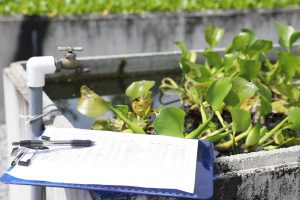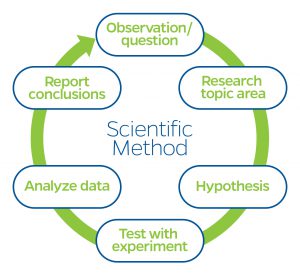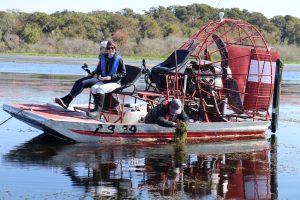Science is responsible for many amazing discoveries. It allowed us to put people in space, cure diseases, and even manage unwanted plants with great precision. The UF/IFAS Center for Aquatic and Invasive Plants (CAIP) was established by the Florida Legislature in 1978, and today it is internationally recognized for having the most relevant information on invasive plant management. At the Center, the scientific method is exercised daily to conduct research that guides management while gaining a better understanding of these plants. This research can be frustrating because the science is slow, but it is worth it.
Using the Scientific Method
Depending on the topic, it can take months or even years for a scientist to deliver solutions. So why does the process take so much time?
To start, a researcher makes an observation that they want to better understand. From there, they read the published literature and speak to experts in order to learn more about this topic. Based on this background information, a hypothesis is developed. Establishing a hypothesis basically means that the researcher develops an idea about what they think is happening and why it occurred.
Next, an experiment is designed to test the hypothesis. This is a key and lengthy (and expensive!) step since you often need specialized equipment or facilities for proper experimentation. The idea is to design an experiment that controls as many variables as possible, so you only test the factors related to the hypothesis. Failure to do this can result in an effect that might have many causes.
For example, you want to test the growth rate and seed production of two plants that are genetically different. To do this, your experiment must provide equal light, temperature, and nutrients. If not, you will not be able to determine if one plant grew faster because it had more resources, because of genetic differences, or both. This is why most projects start in the greenhouse since it is easier to control climate and other factors.
After the experiment has been designed and conducted, a researcher analyzes the results with proper statistical calculations to determine the level of confidence they have in the observations and whether the hypothesis can be validated or discarded. But before we get to the last step, report conclusions, we generally circle back to step four, Test with Experiment.
It is accepted practice that almost all experiments must be conducted at least twice to ensure that the project is repeatable. This is also an internal check to ensure that unintentional mistakes were not made. At this point, most researchers will also conduct additional experiments at larger, less controlled scales. For example, after a couple of experimental runs in the greenhouse show success, you can take the project to the field to see if the results still hold true under the complexities of a natural environment. At this point, the research now has several data sets from greenhouse trials and field data. With the confidence these data provide, the results can be reported, and recommendations can be made.
From this scenario, one can see that it might take 6-12 months of greenhouse work and 1-2 years in the field before the researcher has sufficient confidence in the data. Though it takes a long time, the researcher now has strong data that has been repeated and verified at multiple scales and years. Science is slow, but the confidence it provides is worth it.
Science is Misunderstood
Science can be misunderstood – even by scientists! It is important to recognize that even though science is slow, it is sustainable. It builds upon itself. By bringing the method into play, scientists can ensure a level of credibility to their statements and improve the accuracy of their predictions. Our understanding of science can only get better with time, observation, and communication.
We run into problems when the scientific method is not followed. For example, people will commonly observe changes on their lake, quickly form a hypothesis, and report their thoughts on social media. Though they may be correct in their assumption, they may also be incorrect. Making an observation and immediately reporting it leaves out half the steps in the scientific method and this omission can easily lead to misinformation, anger, and frustration.
For example, an angler has a bad day on the water. Based on past success, they might turn to social media and blame water level, plant management, or lack of stocking as the problem. But the big question remains – are fish populations low because of actions taken by the managing agency, or were they just not biting? We must remember that lakes are ever-changing and complex systems. To answer our questions, we need long-term data – years, if not decades, worth of data.
Observations from stakeholders are priceless. Biologists and agencies need those eyes and ears in the field. But we all need to exercise patience and wait on the conclusions backed by data rather than immediately drawing conclusions and placing blame.
So yes, science is slow, but it is worth it. At CAIP, we work every day to turn science into solutions. If you are interested in learning more about the Center you can visit our website.
This blog post was written by Center Director Dr. Jay Ferrell. Questions or comments can be sent to the UF/IFAS CAIP communications manager at caip@ifas.ufl.edu.
Follow UF/IFAS CAIP on Facebook, Instagram, and Twitter. Read more blogs like this one on the UF/IFAS CAIP blog.
 5
5




